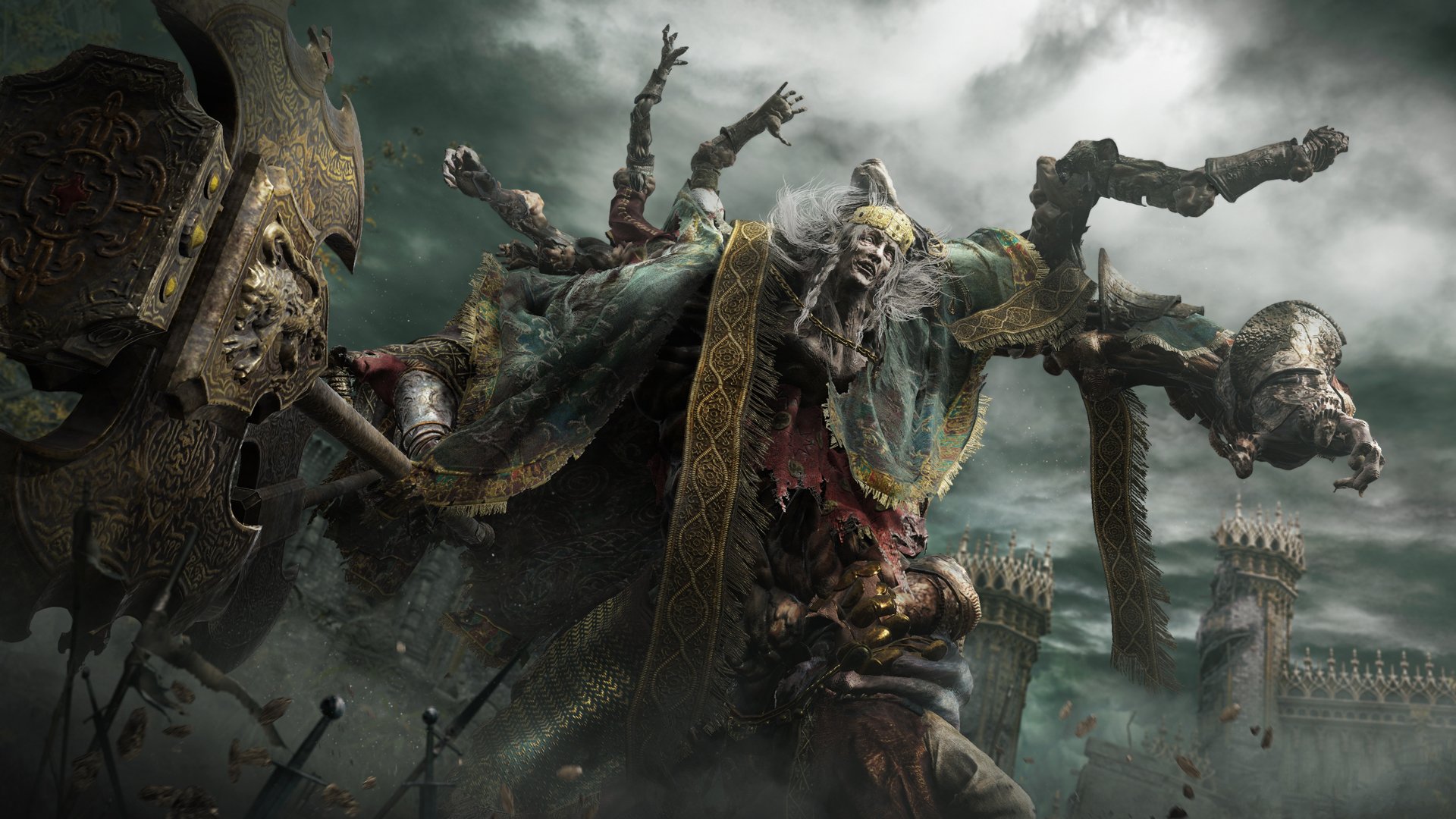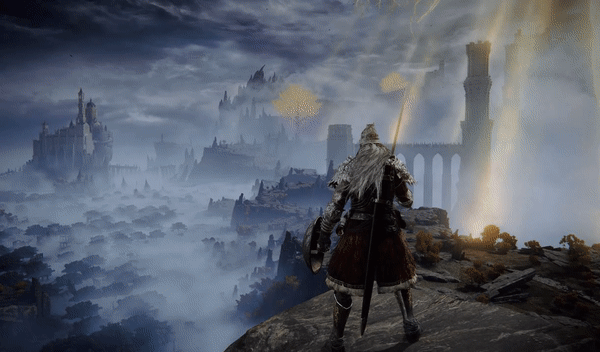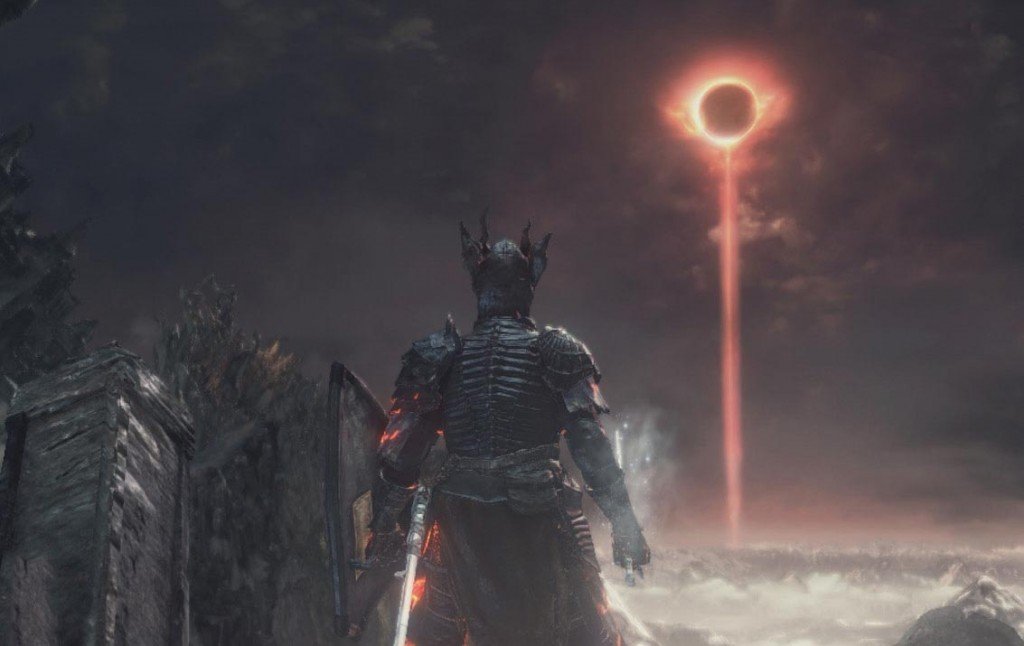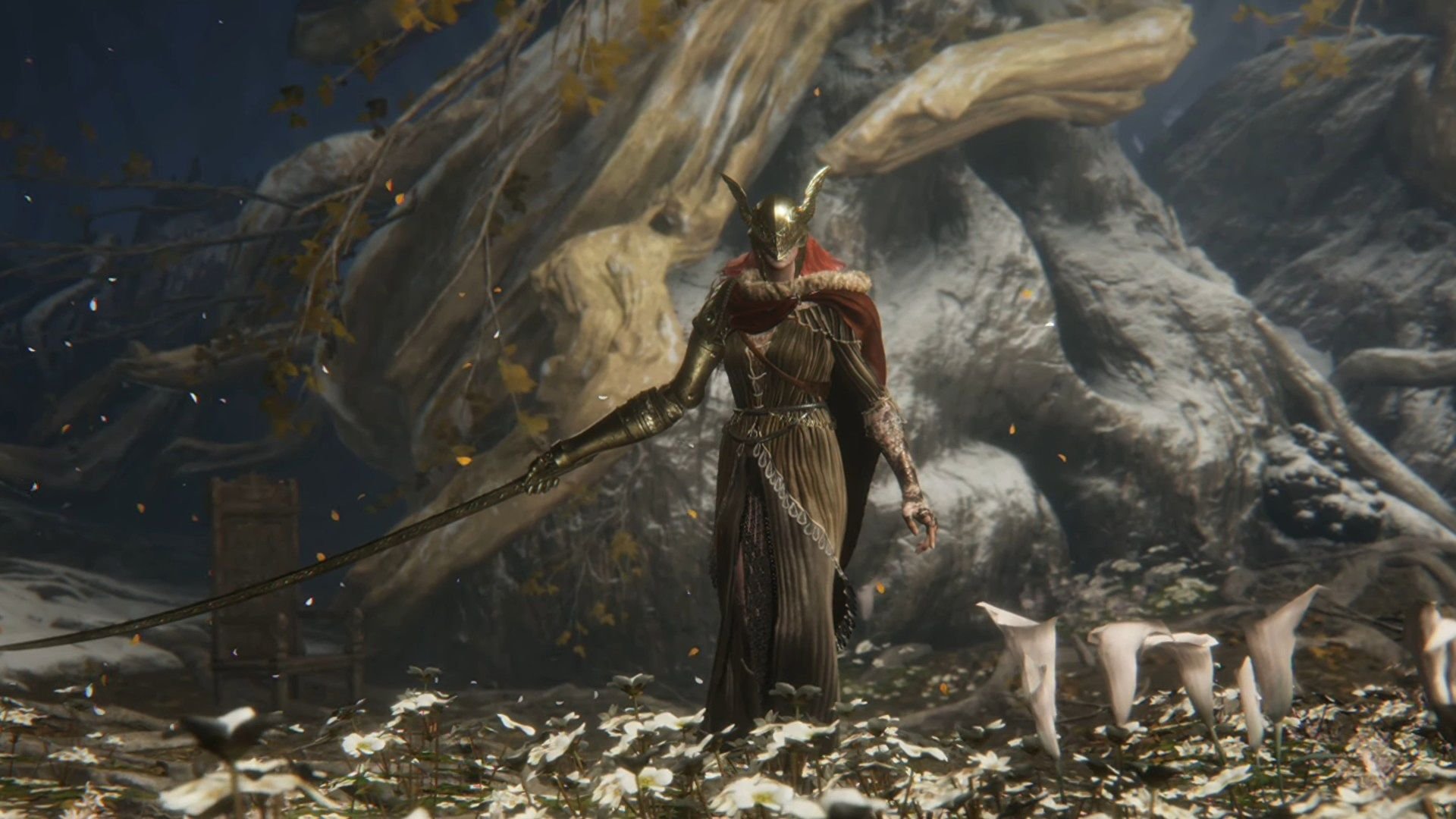Game of The Year: Elden Ring Isn’t Quite A Masterpiece And That’s Okay | Winter Spectacular 2022
Elden Ring is an obvious choice for Game of The Year. In just ten months, it’s sold seventeen-and-a-half million units, ten million shy of all the copies that the original Dark Souls has moved in eleven years. With 91 percent positive reviews on Steam, and a 96 percent score by Metacritic, Elden Ring was always in a good position to sweep every major outlet’s Game of The Year awards
I’m not sure how to describe the style of enemy other than “arms dude”.
Taking much from previous games by FromSoftware, and bringing new ideas to the table, Elden Ring is the first truly open-world Souls game. Even more impressively, it’s managed to do what few games in modern times accomplish, and live up to the hype it generated. It’s expansive, immersive, and creative, with a gorgeous visual style and quietly impactful narrative told through subtle hints and secrets. It’s easy to view it as the culmination of everything FromSoft has been working towards since the days of Demon’s Souls. In fact, I thought this myself on my first playthrough. But, as close as it gets to reaching that nearly unattainable title of masterpiece, it isn’t quite there.
That might seem like an outrageous thing to say about Elden Ring – arguably, it is perfect. Perhaps I’m just stubborn, but I prefer to hold a rating like ‘masterpiece’ in reserve for nearly flawless experiences. Elden Ring is immensely enjoyable, and easily worth the asking price, but as with all the studio’s work up to now, I’d argue it is still only a step on FromSoftware’s journey through videogame development.
It still makes sense to begin with the positive; regardless of all else, it remains fully worthy of being anyone’s pick for the best game of 2022.
Oh, the good times we had dying here.
Striking visual design has never been a weak point for Miyazaki and his team. From the tall castle-scapes of Boletaria, to the golden peaks of Anor Londo, to the soft, ice-laden Painted world of Ariandel, the strength of Fromsoft’s command over the aesthetics in its games has been impeccable from the start. Perhaps it’s owed to the sheer scale of Elden Ring, but this latest instalment might go the furthest of them all.
I remember the first steps I took in the game through the doors of a deconsecrated chapel onto a wide stone dais. Beyond, across an ocean of fog and through lashing silver winds rose the looming shadow of Stormveil castle, great but crumbling battlements capturing a dichotomy of grandeur and ruin. Punctuated by complex crenelations, sculpted masonry, and a distant, dim gleam of gilded furnishings upon the walls, it made for a gripping, yet awe-inspiring view. And it was only the first view of the game. Elden Ring can offer mansion estates straddling lakes of fire, mist-swept plains of silver snow, scarlet fields dotted by toxic megafauna and burning homesteads, and grand citadels in the heart of once mighty cities besieged on all sides by rolling plains of golden grass. We still haven’t even reached enemy or boss designs. These range from the realistic mediaeval swordsman clad in worn chainmail, to the celestial majesty of cosmic beings like Astel and the Elden Beast.
A whole new world!
Taking from mediaeval gothic inspirations, surrealist strangeness, and the studio’s own, carefully crafted brand of grimdark fantasy, Elden Ring offers a feast to the eyes at every turn, and in this particular respect, is like countless fine works of art, sculpted with experience and thoughtfulness.
But even the most painfully beautiful worlds must rest upon foundations. This brings me to Elden Ring’s worldbuilding and its storytelling. Again, the sheer ambition in scope does marvellous justice to what Elden Ring is able to achieve. As an unnamed, unimportant individual raised from death, the player is tasked to bring down demi-gods and gods in the hunt to reunite shattered pieces of a grand rune, the Elden Ring, which once governed the laws of reality. This is a tale of dynasties, a tale of ambition meeting hopelessness, and a tale of despair, and joy within a cruel world. It may not stray far from the chosen-undead-in-a-dying-world formula, but arguably, Elden Ring’s slow but detailed approach results in one of the best executions FromSoft has managed to date. Without forcing you to read pages of item descriptions and watch hours of YouTube videos, there’s enough there for the player to grasp all the basics. But if you want to dive deep into the lore, you just have to explore… or watch VaatiVidya. While I might hold a slight preference for the intricacies and story beats of Dark Souls 3’s story, due perhaps to a bias as my first Souls game, the narrative and worldbuilding in Elden Ring, surrounding and supporting the gameworld, acts as the cement and foundation of the game. It is all of an exceptional quality that in my mind, could alone be enough to earn it Game of The Year.
Sensibly though, FromSoft went all in with its dedication and didn’t stop at creating a larger and deeper world and story. Elden Ring’s gameplay is probably the clearest example of what people mean when they refer to it as a ‘culmination’ of previous titles.
See that castle?
You can get your ass handed to you there.
For an open world, level design largely becomes area design, and in doing so grows in complexity exponentially. But here again, FromSoft excels, utilising colour and unique architecture and fauna to distinguish different parts of the world with clear originality. From’s utilisation of verticality in area design is more apparent than most games, being something the studio has seemingly grown more comfortable with through the development of games like Sekiro: Shadows Die Twice. Some areas even see a return for Metroidvania-esque shortcuts, though still not quite as devilishly well-mapped to the degree that Dark Souls managed to achieve.
Where the player character is concerned, we see perhaps the best culmination of all. Elden Ring manages to incorporate a practical stealth mechanic similar to Sekiro, more refined mobility, highlighted by the inclusion of a mount for faster open-world exploration, and even, to the unbridled joy of Souls fans everywhere, a proper and widely-practical jump button. This comes in addition to more evolved mechanics from previous games, such as customisable Ashes of War that can alter a weapon’s playstyle and special abilities, which many see as a successor to Dark Souls 3’s underwhelming weapon arts mechanic.
Might be tarnished but that dones’t mean I can’t have drip.
All this, backed by the largest suite of weapons, armour and spells in a FromSoft game to date, establish Elden Ring as a fuller RPG than perhaps any of its predecessors.
Combine all these traits we’ve covered so far and it’s easy to see how Elden Ring earns its place as Game of The Year. It’s a gorgeous, creative, and fulfilling open-world RPG, bringing many lessons of previous Souls titles to bear in an entry made far more accessible by way of a stronger command of gameplay mechanics, character dynamics, and aesthetics than ever before. How then, after all this, can I still claim that it is undeserving of a moniker like ‘masterpiece’?
As high as it reaches and as far as it goes, I feel FromSoftware has emboldened by the flame of ambition, as some might say, left behind a few key lessons from previous games.
For me, the simplest flaw this otherwise near-perfect game commits comes from its replayability, or relative lack thereof. This isn’t to say it’s not replayable, but rather, compared to its predecessors, it shows as an area of weakness. Prior to entering Dark Souls 3, I wasn’t the type of person who typically replayed games. Yet upon completing my first run, I found I couldn’t resist immediately starting another. Then another. Then another. Though not often taking focus compared to the many other qualities these games are known for, the limited but meaningful exploration of previous games, with a greater focus on set goals and boss confrontations, has given them a great deal of replayability value. Certainly, a first-time, methodical playthrough of Dark Souls 3 could take 30 hours or more, but the more completions one makes, the faster this can become, all while preserving the repeated enjoyment of challenging these great foes over and over, dancing the duel, and coming out on top. The inherent difficulty and the demand for attention and concentration mean that even after fighting bosses several times, players can come away with a sense of satisfaction.
Now let’s do it again.
Now compare Elden Ring. It’s by far the largest and the longest Fromsoftware game to date, and a complete playthrough can easily take 100 hours. Even if you shaved that down with faster and faster runs, that’s a lot of time to ask from anybody. This is only hampered further by the fact that, unlike previous games, Elden Ring’s primary focus is not on bosses or even narrative, but on exploration, a facet that relies on a sense of mystery and the unknown to be compelling, and which therefore naturally loses potency on subsequent runs as there becomes less and less for players to find. In a sense, this isn’t Elden Ring’s fault, and it’s simply the nature of the type of game, but in my mind replayability is something crucial to a good Souls or Souls-like title, and a cornerstone of the long-term enjoyment fans can derive from the experience.
Despite this issue, Elden Ring could still find plenty more replayability than it possesses by virtue of excellent and gripping boss fights, but here we come to the cardinal failure of Elden Ring, the one that, in a way, seems as though it should never have been able to occur: the bosses.
Hello friend!
I’m not saying the boss fights in Elden Ring are bad. They aren’t – this is still a game developed by the team behind Artorias and Ludwig, The Holy Blade. But compared to other Souls games, on a mechanical level, and in terms of wider gameplay distribution, they are for the most part a significant step-down.
Let’s start with the distribution. Personally, this was my greatest problem with the game. While scale and scope are grand, it’s clear that development struggled to keep pace with approaching deadlines. In a mirror to the first Dark Souls, many areas in the latter half of the game suffer from a less expansive degree of identity and depth, and this is clearest of all from mini-boss encounters throughout the world. Diving into a catacomb can certainly be fun, but if after twenty minutes of exploration in a sadly repetitive environment, one finally reaches the boss room at the end, is it not a disappointment to find the foe waiting within to be a standard enemy with a boss health bar? Or worse yet, two standard enemies with boss health bars? The reuse of bosses and enemies in this way felt greatly disappointing to me, diluting some of the otherwise potent flavours the game has to offer. Certainly, some of the most unique bosses, like Astel, felt a small part reduced in grandeur by encountering one deep within the heart of a primordial underground cavern, and another at the end of a five-minute trip down a mine shaft.
Kill one giant bear, you’ve killed them all, y’know?
Then comes boss mechanics, and here we find not so much a missed step as a misjudgement. By the end of Dark Souls 3, FromSoft’s boss design had arguably reached a peak. Slave Knight Gael and Darkeater Midir are rightfully hailed as some if not the best bosses in the series’ history. Gael in particular, between his musical score, his tempo, his damage output, and his overall balance, allows the player to strike that perfect duelling dance as mentioned earlier; in all my playthroughs, I’ve never once taken a hit from Gael that I felt was genuinely unfair. Elden Ring however struggles with this. As players have grown increasingly competent, FromSoft has seemingly misinterpreted this fact as a sign of the necessity for harder and harder boss fights. In part, this has led to poorly balanced bosses in Elden Ring. Extreme speed, larger combo chains, fewer recovery frames, and new AI abilities like input reading have led some to argue that bosses are challenging to the point of unfairness in Elden Ring. Often, boss fights in Souls games have relied on an element of strategy, with the end of combos or particular moves providing consistent openings any motivated player could learn, thus allowing anyone to overcome obstacles with time and patience. While the argument here depends largely on personal perspective, it does seem at odds with FromSoft’s attempts to make Elden Ring the most accessible game of the series. As far as truly solo experiences go with many of these bosses though, there is little denying that they demand immense challenge, unfair or otherwise.
Listen we would never claim a Souls boss is unfair…but………………..
FromSoft itself seems to have realised this though, and consequently tried to rectify the situation through other mechanics. There are of course some infamous weapons, simply unbalanced to the point of making most fights a joke. I watched a friend, a Souls newbie, down Malenia with ease after ten attempts thanks to the godly combination that the Bloodhound’s Step Ash of War and the Rivers of Blood katana. The worst offender by far though may be the spirit summons system. While on paper an excellent way to add new dynamics to the fight, or balance encounters with large groups of enemies while exploring, in practice the summons system largely broke any boss fight it was deployed into. Some summons, like Mimic Tear, could unleash simply ridiculous amounts of damage when used well. But even the weakest summons provided a bonus that turned all duels trivial – splitting the boss’s attention. This emulates that sense of strategy, but the openings of course are generated artificially, often far too long and far too frequent. Most of the time, this turns overly challenging boss fights into simple affairs, denying much of the sense of satisfaction a victory could otherwise bring for many players.
While I still maintain that the boss fights of Elden Ring are wholly capable of being fun, there does appear a lack of refinement compared to the likes of Ornstein and Smough, Sister Friede, or Sir Alonne. FromSoft’s failure to properly balance these encounters can lead to them being too hard, or too easy, and missing the vital sweet spot in between that Souls fans crave. And that, in my opinion at least, is a serious problem.
Things Elden Ring Does Right: This ^
Elden Ring is marvellous. It does so many things right, from worldbuilding to aesthetics to exploration, taking some from previous titles, and exploring some new territory that FromSoft was yet to tread. Elden Ring is also frustrating, struggling to reach a ‘culmination’ of the previous games by missing the mark on balance and boss design. But ultimately, this remains a work of immense effort, heart and dedication from a studio that has routinely done all it can to provide fantastic gaming experiences. And it won’t be the last.
Speculation runs high for what future DLCs might bring to the table, and (excluding some certain areas of Dark Souls 2) FromSoft has a history of presenting its best work and most memorable bosses in this extra content. With the success it has brought on there can also be little doubt that FromSoftware will go on to produce many more Souls and Souls-likes in the years to come, and the growth it has shown in the creation of Elden Ring is proof that the team can and will learn to improve with every project.
It might not be perfect, but it doesn’t have to be. It might not quite reach a ‘masterpiece’ status for some, and that’s okay. Elden Ring is still a triumphant success, and a labour of love few who have played can deny enjoying. In my mind, and in seventeen million others, it is well-deserving of taking Game of The Year.














